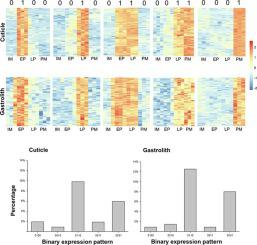Journal of Structural Biology ( IF 3.0 ) Pub Date : 2020-09-05 , DOI: 10.1016/j.jsb.2020.107612 Shai A Shaked 1 , Shai Abehsera 1 , Tom Levy 1 , Vered Chalifa-Caspi 2 , Amir Sagi 1

|
One fundamental character common to pancrustaceans (Crustacea and Hexapoda) is a mineralized rigid exoskeleton whose principal organic components are chitin and proteins. In contrast to traditional research in the field that has been devoted to the structural and physicochemical aspects of biomineralization, the present study explores transcriptomic aspects of biomineralization as a first step towards adding a complementary molecular layer to this field. The rigidity of the exoskeleton in pancrustaceans dictates essential molt cycles enabling morphological changes and growth. Thus, formation and mineralization of the exoskeleton are concomitant to the timeline of the molt cycle. Skeletal proteinaceous toolkit elements have been discovered in previous studies using innovative molt-related binary gene expression patterns derived from transcriptomic libraries representing the major stages comprising the molt cycle of the decapod crustacean Cherax quadricarinatus. Here, we revisited some prominent exoskeleton-related structural proteins encoding and, using the above molt-related binary pattern methodology, enlarged the transcriptomic database of C. quadricarinatus. The latter was done by establishing a new transcriptomic library of the cuticle forming epithelium and molar tooth at four different molt stages (i.e., inter-molt, early pre-molt, late pre-molt and post-molt) and incorporating it to a previous transcriptome derived from the gastroliths and mandible. The wider multigenic approach facilitated by the newly expanded transcriptomic database not only revisited single genes of the molecular toolkit, but also provided both scattered and specific information that broaden the overview of proteins and gene clusters which are involved in the construction and biomineralization of the exoskeleton in decapod crustaceans.
中文翻译:

从零星的单个基因到更广泛的转录组学方法:深入了解十足目甲壳类动物生物矿化外骨骼的形成。
Pancrustaceans(甲壳纲和六足纲)的一个共同基本特征是矿化的刚性外骨骼,其主要有机成分是几丁质和蛋白质。与该领域致力于生物矿化的结构和物理化学方面的传统研究相比,本研究探索了生物矿化的转录组学方面,作为向该领域添加互补分子层的第一步。甲壳类动物外骨骼的刚性决定了必要的蜕皮周期,使形态变化和生长成为可能。因此,外骨骼的形成和矿化伴随着蜕皮周期的时间线。螯虾。在这里,我们重新审视了一些突出的外骨骼相关结构蛋白编码,并使用上述与蜕皮相关的二元模式方法,扩大了C. quadricarinatus的转录组数据库. 后者是通过在四个不同的蜕皮阶段(即蜕皮间、早期蜕皮、晚期蜕皮和蜕皮后)建立表皮形成上皮和磨牙的新转录组文库并将其合并到先前的源自胃石和下颌骨的转录组。新扩展的转录组数据库促进了更广泛的多基因方法,不仅重新审视了分子工具包的单个基因,而且还提供了分散和特定的信息,拓宽了参与外骨骼构建和生物矿化的蛋白质和基因簇的概述。十足目甲壳类动物。







































 京公网安备 11010802027423号
京公网安备 11010802027423号